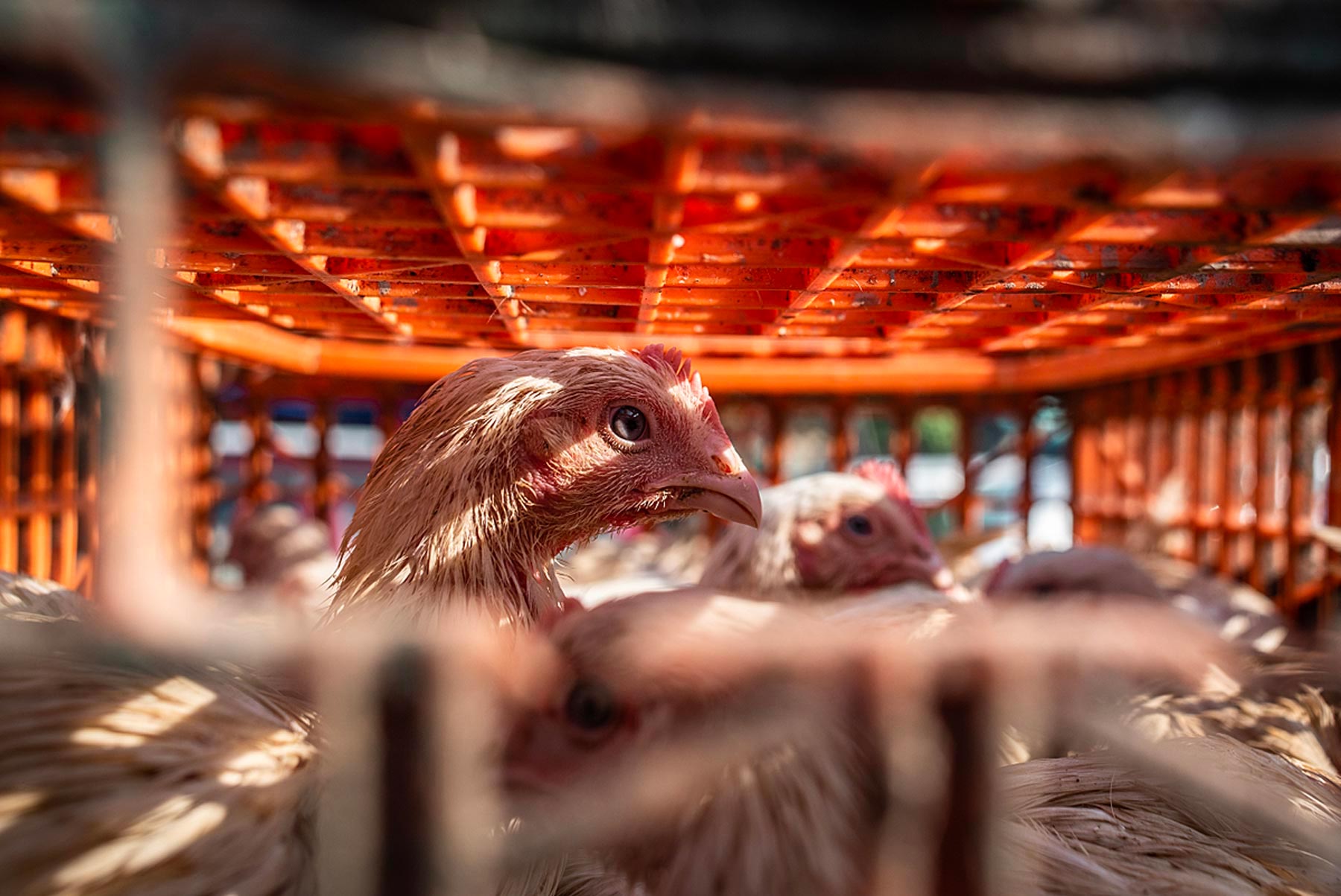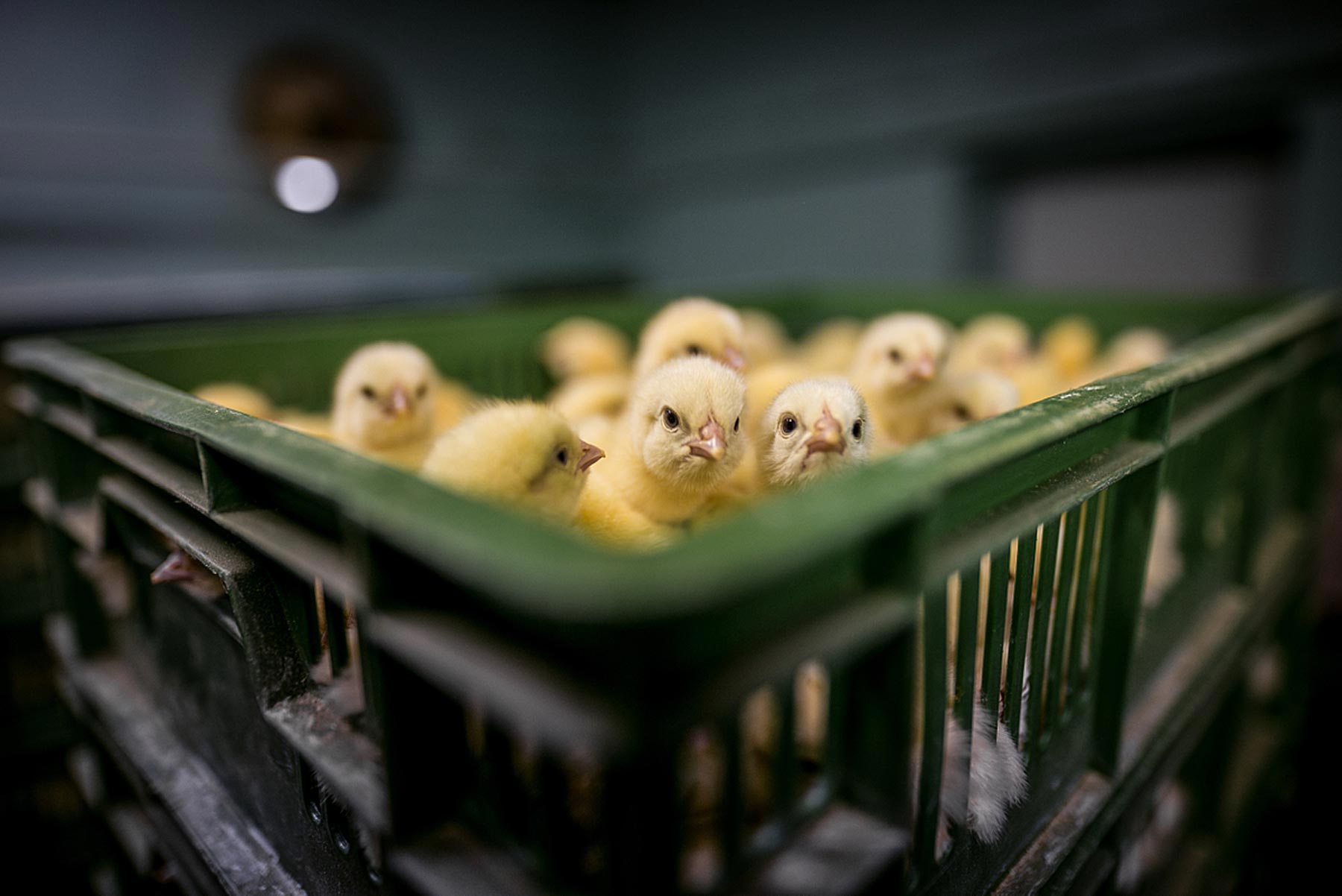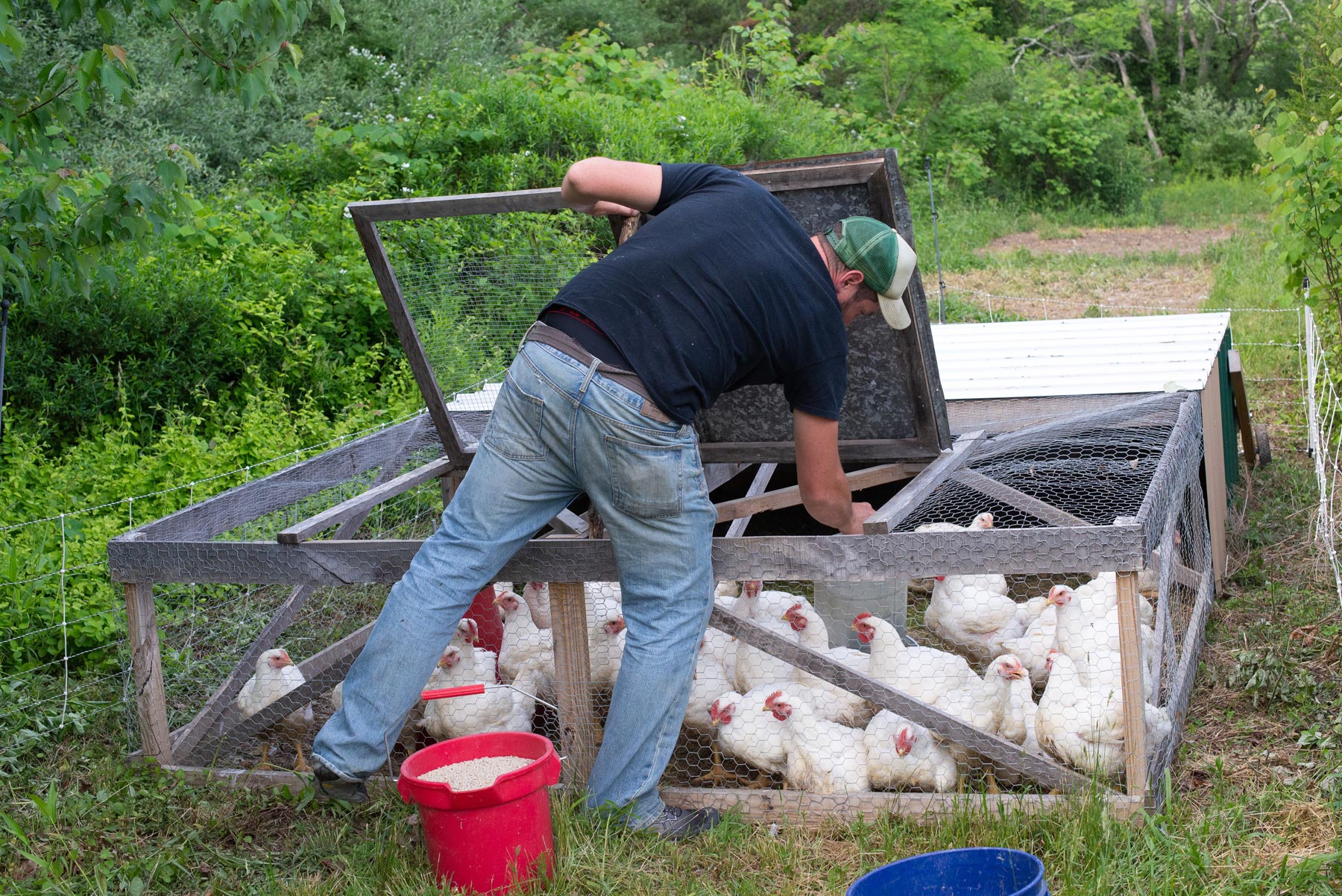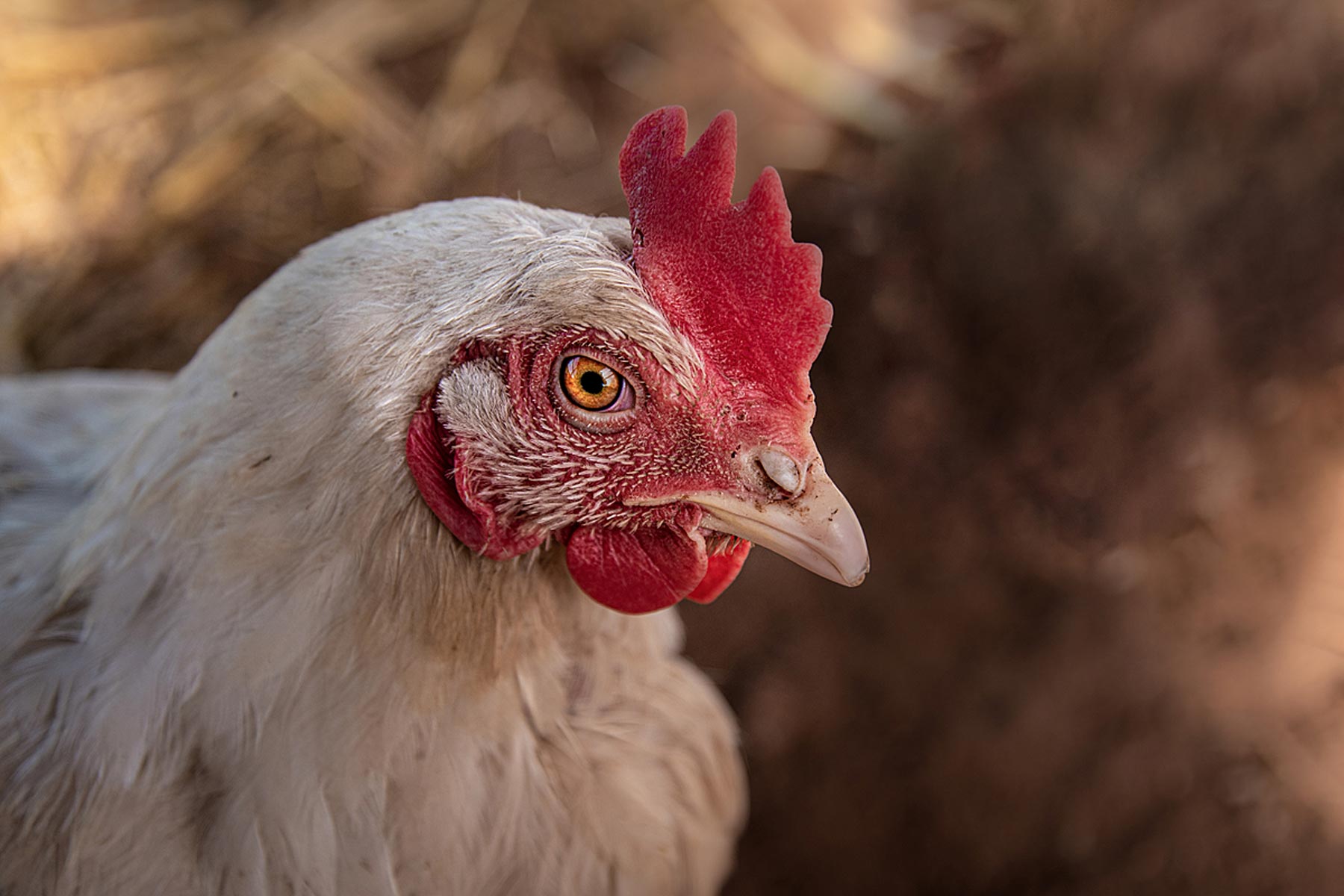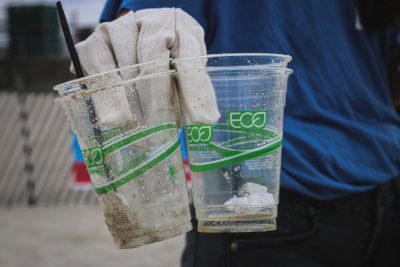As the suffering of birds in the meat and egg industries becomes more well known, consumers are increasingly looking for kinder ways to eat. They see terms like ‘free-range’ and ‘cage-free’ and may imagine the birds are roaming across wide open pastures or prairies, enjoying a happy, natural existence. Unfortunately this couldn’t be further from the truth.
What Is a Free-Range Chicken Farm?
A shocking 99.9 percent of chickens in the United States are factory-farmed with just a small number raised on free-range farms. Shockingly, however, there is no legal definition of what constitutes ‘free-range’. And this means corners are cut. For most ‘free-range’ birds, the conditions are little better than those afforded to factory-farmed birds.
First, is the question of how much space they have. Two thirds of chickens on free-range farms have less than two square feet of outdoor space each.
Then comes the question of the quality of this space. There is zero government oversight over this, and often it is nothing more than a barren concrete yard. It may even be covered and walled, so the birds are not technically outside at all.
And finally, there is the issue of how much access the birds actually get to it. Thousands of birds trying to access one small area is a recipe for disaster. Chickens are notoriously teritorial and since access to the yard is through small openings in the wall, smaller or weaker birds do not feel comfortable crossing the territory of stronger birds. These ‘free-range’ birds spend their whole lives inside.
For the majority of chickens a free-range farm is still a barren prison.
Chicken Raised for Eggs
Around 98 percent of all chickens farmed for their eggs live on factory farms, with no access at all to the outdoors. Most spend their entire lives in small cages alongside several other birds with each allotted space the size of an iPad to live in. Fewer than two percent of hens are kept on free-range farms which, as we have seen above, does not mean a huge improvement in terms of their welfare.
Egg industry marketing is frequently misleading. There are no ‘happy hens’. Whatever the system they are kept in, hens reared for their eggs start their lives inside industrial hatcheries. For every female hatched in the giant incubators, a male chick is also hatched, but these young birds cannot lay eggs and are deemed worthless by the industry. They are killed on their first day of life—gassed, crushed or macerated. Their sisters may have the ends of their beaks cut off (to prevent the stressed birds harming one another) and then be packed into crates and transported to a farm. Millions die from the appalling conditions.
The terms ‘free-range,’ ‘cage-free,’ and ‘humane’ are designed to reassure the public that the birds had a good life, so that people keep buying their eggs. If they knew the hardships and suffering these birds had endured, most would surely stop.
Take a look at this British free-range egg farm. And these ones are no better.
Chicken Raised for Meat
99 percent of chickens raised for their meat in the US are incarcerated inside factory farms where they live utterly miserable lives. They are afforded very little space to move, no fresh air, and nothing to occupy their bright and inquisitive minds. For the ‘lucky’ one percent who live on free-range farms, things are actually not much better.
Legally, a free-range farm must only offer ‘access’ to an outdoor area, and in many cases this is no more than a small concrete yard. The birds are unable to root in the earth as they would naturally, and there are no trees for roosting, or pasture to roam in. In fact, there is nothing at all. They can stand outside on concrete that damages their feet or they can stand inside on a floor that is wet with animal waste that burns their skin.
And being free-range or organic does not spare birds an appalling death at the very same slaughterhouses that factory-farmed chickens are sent to. At the age of just 6-12 weeks, they are hung upside down by their legs, dragged through electrified water, and have their throats cut.
How Does a Free-Range Chicken Farm Work?
Free-range systems provide no protection from the routine and systemic suffering inflicted on birds. This includes mutilations, lameness, broken bones, heart failure, and millions of birds suffering to death right there in the sheds.
Male Chicks Are Trashed At Birth
In all egg farming systems, including free-range, cage-free, and organic, male chickens are considered useless. Their bodies cannot be monetized as they cannot lay eggs and they are considered too scrawny to be reared for their meat. So, the males are disposed of minutes after they hatch.
Hatcheries say they do this in the most ‘humane’ way possible, but the truth is the tiny chicks are gassed, crushed or minced alive. This is how little the industry values animals, even in so-called ‘higher welfare’ systems. Isn’t it time to end our support for these practices?
Chicks Are Debeaked
Debeaking is the removal of a chicken’s beak, usually straight after hatching, with a searing hot blade at around 700 degrees celsius. It can cause both acute and chronic pain, with some birds left unable to eat as a result. What’s completely despicable is this is done only to prevent birds pecking one another—something they do because of the incredible stress they endure within the factory farm system. Debeaking is a mutilation that is legal and commonplace but it would not be necessary if the birds’ needs were met.
Free or Not, All Hens Are Slaughtered
The natural lifespan of chickens is 5-10 years, but birds who are farmed for meat, whether they are kept free-range or not, will live just 6-8 weeks, or around 12 weeks on some organic farms. During this time, their bodies balloon to an unnaturally large size for their age because they have been selectively bred to grow as big as possible as fast as possible. Such rapid weight gain puts immense pressure on their bones, and it is common for hips to become displaced and leg bones to break. Heart failure is also a common side-effect of this unnatural weight gain. Whether they live a truly free-range existence, are given access to a concrete yard, or are factory farmed, all chickens end up at the same horrifying slaughterhouses when just a few weeks old.
Hens exploited by the egg industry are only deemed profitable whilst they produce an unnaturally high number of eggs. This comes at an immense cost to them, as all those eggshells require calcium, which comes from the animals’ bones. Osteoporosis, fractures, and broken bones are commonplace. And still, they are forced to stand in wire cages, trapped alongside a number of other frightened and stressed birds. Treating animals this way takes a huge toll on them. At around 12-18 months old, their laying rate decreases, and at this point the industry can save money by sending them to slaughter, and caging another bird in their place.
What Does a Free-range Chicken Farm Look Like?
Because there is no legal oversight of what ‘free-range’ farms should look like, there is huge variation in standards. There are a few, very few, genuinely free-range farms, where birds have regular access to an interesting and interactive space. For the majority of ‘free range’ birds, the farm will resemble a typical factory farm, because that is essentially what it is.
Can Chicken Survive Free-Range?
Very few chickens survive the farming system. They are slaughtered long before their natural lifespan is over. A lucky few may be rescued and they may recover from their ordeal and be able to enjoy their first steps on grass and the feel of sunshine on their backs. Birds rescued from the meat trade are normally so sick that they do not survive long. Hens rescued from the egg trade often do better, and may have many happy years in a loving home. But these are very rare cases. Most birds cannot escape the system.
How Much Land do Chickens Need to be Free-range?
That depends who you ask! People who really care for chickens say they need acres of land with earth, trees and grass to fulfill their natural behaviors. But, according to the USDA, chickens need just two square feet of outdoor space for the farm to be considered free-range. And that says nothing about the quality of the space or how the birds might get access to it. It is obvious that this is not sufficient to give sentient beings a meaningful and enjoyable life. But this is the best that the industry offers. The only way to end this is to boycott the products, as it is our purchases that fund this cruel treatment.
Conclusion
Terms like ‘free-range’ are designed to convince us that animals have a decent life so that we continue to buy chicken meat and eggs in blissful ignorance of the truth.
Farming is a business, and profits trump compassion every time. Without meaningful, legally mandated standards, terms like ‘free-range’ are essentially meaningless. They may ease our consciences but they do very little to prevent suffering and to provide the birds with a life worth living.
We can stop this simply by stopping our consumption of chicken meat and eggs. There are excellent vegan alternatives available, and we could enjoy those with a truly clear conscience, knowing that our purchases are not propping up an unconscionable system of exploitation and suffering.

